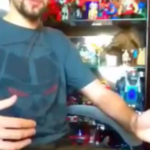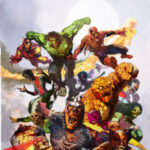It’s been some time since the conclusion of Grant Morrison’s controversial run on Marvel Comics’ New X-Men series. However, even now, years later, readers still have questions about the man’s forty-one issue run (#114-#154 plus the 2001 Annual). This is intended to serve as a sort of guide to Morrison’s run for people who may still have some questions. Let’s go through and examine the major characters in the run:
CYCLOPS – Without a doubt, the central character in Morrison’s run would have to be Scott Summers. Prior to Morrison’s run, Cyclops “died” in a sense, becoming possessed by Apocalypse (or his true name, En Sabah Nur as he’s referred to throughout the run). Cyclops acts as a metaphor for the X-Men books as a whole-he’s afraid to change, he’s never been allowed to be anything other than a superhero. In comes Emma Frost, and suddenly, Cyclops discovers a new world that he never knew existed. He feels like he’s suffocating-he feels all these new emotions and has these desires from before. At first, his wife, Jean, explains this as residual from Apocalypse’s possession–“You’re not the only person who was ever possessed by an evil spirit, Scott… the bad feeling goes away.”). Scott’s reply to this comment from his wife shows us that he has changed from the beginning–I don’t know if I feel bad, Jean. I just feel strange and different, that’s all, and I don’t want to hurt you or anyone.” We see other quotes from Cyclops throughout the run that help to identify him as lost, feeling without a sense of purpose or belonging–“I can’t make it feel like it used to…” he says to Jean. It is with Cyclops that the deconstruction of the X-Men mythos begins. The themes of sexuality are also a very big part of Cyclops and his optic blasts are a phallic symbol. We first discover this in “Germ-Free Generation” when his optic blast strikes the Statue of David in the nether regions. In “Assault on Weapon Plus,” Cyclops is at the Hellfire Club watching as a woman strips and he says it’s sexless and unarousing and there’s a close-up on his visor. After this, he finds he isn’t able to unleash his optic blasts. After Jean discovered about his psychic affair with Emma, he tried to run from his desires, he tried to hide them.
EMMA FROST – The former White Queen turned X-Man, Emma represents a hope for the future, a chance for change. She joins up with the X-Men to cause trouble, to shake things up, but she finds herself falling in love with Cyclops, who is arguably the epitome of the X-Men. In this way, Emma is essentially Morrison writing himself into the story. If you look back on Morrison’s interviews which came before his first issue was released, he talked about how he would shake things up. He promised love triangles and soap operas and he promised us change. That’s what Emma promises us, but like Emma, Morrison fell in love with these characters and with what makes them work.
JEAN GREY – Another crucial part of New X-Men is Scott’s wife, Jean Grey-Summers. You should notice that I didn’t call her Phoenix and there is a reason for that, which I will address in a moment. Jean is past of the X-Men books. She knows something is wrong, but she doesn’t know how to fix it, so instead she tries to ignore the problem, hoping it will go away, demonstrated when she says, “…this marriage feels very strange and cold, Scott” as well as her refusal to read Scott’s mind when he asks her to. Jean is also a power junkie. During the first story-arc, “E is for Extinction,” Jean appears very restrained and uptight and she’s lonely. But at the end of “Germ-Free Generation,” she becomes a different person after her Phoenix manifestation (“…I feel amazing, Logan. I had all these negative feelings about Scott, but… they’re gone now. I feel great. Did you see what I just did?”). Like the old reader, Jean still longs for those power struggles and to bring things back to the way they were. Which is, in a sense, a bit contradictory given that a book like X-Men is supposed to be about change and evolution, and Jean herself makes note of this contradiction in the “Murder at the Mansion” story-arc–“…I have the worst temper, Bishop. I run around the world preaching peace and brotherhood, and when I come home, the first thing I do is fight.” Because Jean represents the past, this is why it is necessary for her to die at the end of the run, because only with the death can change come about–and her death indeed does cause a change. With her gone, Cyclops first leaves and everything falls apart. Or Cyclops stays with Emma and we see hope for the future. But Morrison knows that even if Cyclops embraces Emma, that even if the X-Men mythos embrace the future and a chance for change–the old ways will eventually return, just like the Phoenix will always rise again.
PROFESSOR X – Charles is sort of lost in a state of limbo. He’s still trying to cling to his dream, still trying to cling to why he started this all in the first place (Beast: “He’s trying to remind himself what it’s all for.”). He even attempts to embrace the future after the death of Magneto and after Cassandra forces him to out himself. He tries the new way, the pro-mutant way, but in the end, his prize student (Quentin Quire) rebels against him and turns to the “dark side.” But Xavier is perhaps a bit to blame for that, because with his new pro-mutant stance that tends to alienate humans (“We’re in no mood to play chimpanzee politics.”). With Magneto now gone, Xavier has no polar opposite and in a way, he has no one to keep him in check–this is something we’ve seen before, with “Onslaught,” and it is for this reason that one of the memories Xavier loses when Jean contains his mind within her own is the memory of “how good it felt to overcome the monster Onslaught.” Xavier is going in circles with his dream and as the architect of the dream, he represents, perhaps, veteran X-Men writer Chris Claremont, who is credited as being the architect of the X-Men. Notice how when Xavier recovers from another evil entity taking control of his body, he is able to walk–but once his old rival returns from the dead yet again to terrorize the world yet again, Xavier loses the use of his legs yet again. It’s all an endless cycle, which is why at the end of “Riot At Xavier’s,” he essentially gives up by stepping down as headmaster and this is why at the end of “Planet X,” he says to Magneto, “Perhaps it is time we put away the old dreams, the old manifestos… and just listened for a while.”
BEAST – A frequent criticism I’ve heard of Morrison is that Beast was essentially shoehorned into New X-Men, that the character had no real purpose. This is a bit of an inaccuracy. Beast is the X-Men reader who is on the fence–he has changed since he came into the books, several times and he misses the old days. But at the same time, he realizes that change is inevitable. Notice that all the X-Men go through a sort of evolution in the course of the book. At first, Beast tries to stay with the old ways, which is why he tries to reason with Cassandra Nova as a human being and he ends up becoming mortally injured. Then, he tries to throw away the old ways and go completely with the new, and he pulls stunts to show this off (pretending to be gay, his comment that “all humans look alike to me”).
WOLVERINE – In a way, Wolverine represents everything that’s wrong with the X-Men. The X-Men are about evolution and change and pacifist ideas and who is their most popular member? A mutant who never ages and, in his own words, “all I’m good for’s killing.” There’s a reason Morrison keeps Wolverine in the background for most of his run, and the reason for that is because he understands that Wolverine shouldn’t really have a place in a book about pacifism. And the story-arc where Wolverine comes to the forefront? “Assault on Weapon Plus,” an action-oriented story-arc that focuses on Wolverine, the trigger-happy Fantomex, and a disillusioned Cyclops. And we know that it is contradictory to the X-Men because first Wolverine reminds Cyclops several times that they’re not on an X-Men mission and Cyclops says to Wolverine, “X-jackets off.” And where do they go on this mission? Into the World, where time is stopped and started as the creators please. And who is behind the Weapon Plus Program? Sublime, who I will get to soon.
FANTOMEX – I would think that it is obvious at this point to most people, but Fantomex was created as satire–a spoof on every mystery bad-ass character created in the pages of the X-books in an attempt to capitalize on the appeal of Wolverine, and we see this in several ways. Fantomex was created by the same program that created Wolverine. Wolverine has a healing factor, Fantomex has a nervous system separate from his body. Wolverine is Canadian, Fantomex is French (or he pretends to be–how ironic that the latest bad-ass character pretends to be French, the people criticized for surrendering). Both have no scruples about killing. And Fantomex even dresses in the trademark bad-ass clothes–flowing trench coat, hidden face, a “ninja-Matrix freak” as Monet calls him. The irony in this is that the bad-ass acts as if Jean Grey was interested in him, when in reality she seemed to simply pity him for his attempts to prove his attraction. And perhaps the greatest line to come out of Fantomex’s mouth is when he says to Magneto, “is everything you say a cliché?” when in fact, everything both of them says is a cliché. In “Assault on Weapon Plus,” we discover the truth behind Fantomex. He was created by Weapon Plus and Sublime to be the cool stealth killer for their team of Super Sentinels.
MAGNETO/XORN – Ah yes, one of the frequent criticisms has also been Morrison’s portrayal of Magneto. But what many people do not seem to understand is that we only see the real Magneto in a few places–the place where Magneto appears the least is in fact “Planet X,” the story-arc where Magneto is supposed to be the focal point. Except it’s not really Magneto, it’s only a shadow of who he really is. The “Magneto was posing as Xorn” explanation is something that hasn’t sat well with many people and don’t worry, I will get to that momentarily. All throughout “Planet X,” we don’t see Magneto–we see Sublime controlling Magneto like a puppet (right before Magneto cripples Xavier, he says, “I’ve been holding you up–and now I’m cutting your strings.”–a reference that Sublime is in fact the puppet master). There is one time when we see the true Magneto in “Planet X.” It is right after Magneto tells Esme that she’s nothing to him but a means to an end. “You made Xorn too well–in the image of your idealism, your strength, your wisdom. I am your inner star, Erik. I am the conscience you can never silence. I will never let you be.” We know this isn’t Xavier, because his mind is blocked. And we know it isn’t Phoenix, because the word balloon isn’t black and isn’t in the form of a telepathic bubble. The questions people always ask–why would Magneto use drugs? Why would Magneto reverse the poles? Simple answer–he wouldn’t. But Sublime would. Remember, in “Here Comes Tomorrow,” Wolverine said to Jean, “Magneto killed you under orders he never understood.” Magneto, like Cassandra, is a metaphor for the writers of the X-Men books–a puppet at the mercy of the puppet master. We see the real Magneto in Xorn’s solo issue (#127, “Of Living And Dying”). Also, in the 2001 Annual, “The Man From Room X,” a lot of people are confused about how these events transpired. Who was Ao Jun and what was Sublime’s involvement? Ao Jun was a mutant servant of Magneto who built Feng Tu to give Magneto a safe haven after Genosha, a place he could recuperate. With Sublime’s U-Men harvesting mutant organs, I imagine it was Ao Jun’s plan to try and lure Sublime with the prospect of a mutant with a star for a brain and used the pretext of Xorn to lure him in. After Sublime was betrayed by Ao Jun however, Magneto escaped. You notice that Xorn didn’t go right to the X-Men’s side, instead he went into seclusion for a time. It wasn’t Magneto’s intention to infiltrate the X-Men under the Xorn pretense–Xorn was simply concocted to allow Magneto to bide his time and lick his wounds. It was during this time that Sublime took over Magneto and, under the Xorn guise, infiltrated the X-Men.
CASSANDRA NOVA – Something else which requires explanation is Cassandra Nova. She is not Xavier’s Mummudrai, or the “bizarro-Xavier,” if you will. She is, simply put, Xavier’s twin sister who was stillborn brought back to life and forced to commit the Genoshan massacre under the orders of Sublime. At the end of “Imperial,” that is why Cassandra Nova’s mind was wiped blank–it was always blank, Sublime was just forced out from her body once she merged with Stuff. And this is because Stuff was an alien lifeform and Sublime, despite all its power, is still Earth-based. More importantly, Cassandra is the new reader. New to the X-Men, knows nothing of the past, “a synthetic brain programmed to learn.” That is why the first thing Jean draws on the blackboard when Xavier says, “let’s start from the beginning” is a giant X. Oh and for the record, Cassandra and Ernst are the same person. Just to put that to rest.
SUBLIME – Look back to New X-Men #154, Morrison’s final issue. In the first pages, read Sublime’s words, “The cataclysmic primal screams of the newborn Earth woke us. And we knew ourselves as one mind. And we were ‘first genome.’ RNA. DNA. Perfectly-adapted form. The pinnacle of evolution. Self-aware, immortal. Sublime.” Sublime was more than just John Sublime, a human who wanted to be a mutant. Sublime was more than the mutant-enhancing drug, Kick. Sublime was bacteria fighting against evolution, trying to stop change. You can look at Sublime as a metaphor for the editors on the X-Men books. Why did Magneto keep coming back to life to cause a lot of trouble? Because the editors wished it that way. Why is it the X-Men keep getting brought “back to basics,” why is there a revamp of the X-Men every few years or so? Because of the editors. The editors are the ones fighting change, because it’s unknown, they fear it. Because if change doesn’t work out in their favor, it’s the end for them and their jobs are over. Just like with Sublime, if evolution doesn’t work out in its favor, its job is over. Sublime was the one who caused Cassandra to kill 16 million mutants in Genosha. Sublime was the one who caused Quentin to riot. Sublime was the one behind the Weapon Plus Program and the “gimmick” idea of marketing super soldiers to the public. Sublime was the one who caused Magneto to destroy New York and kill Jean. And it was Sublime who brought Jean back to life in the future after killing her.
Ultimately, New X-Men is a deconstruction story of the X-Men because it’s telling the readers that it’s time to grow up. This is told to us in a number of different ways, but the finest example is Cyclops’ conversation with Wolverine at the Hellfire Club in “Assault on Weapon Plus,” where Cyclops says, “Jean and I have known each other for so long, Logan… every time I look at her I see this teenage girl I met… and I feel like a teenage boy. But I’m not anymore.” What Morrison is saying is, “yeah, the glory days of the X-Men were great and all… but life is change and we all have to grow up sometime.” He recognizes that it’s not always the reader’s fault that change never comes, or that it comes too rapidly. It is Sublime, in its metaphor for the editorial control, that kills Jean suddenly and ruins everything and it is Sublime that brings Jean back years later to make everything work to its advantage. At the end, Jean makes a conscious decision to allow change to flourish and Scott embraces the new age. But we all know what happens next… the costumes return, the heroics return, and now Jean is returning. Like a Phoenix from the ashes, the old days return once more. Thus, the cycle begins anew, and that is what Morrison was showing us.





